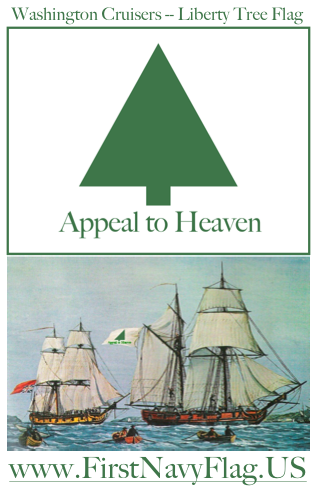

30 January 2006
Captain P. O. Wheeler, U. S. Navy
Deputy Director of Naval History
2000 Navy Pentagon
Washington, District of Columbia 20350-2000
Dear Captain Wheeler:
Thank you for your letter of 23 January, postmarked on 25 January 2006, that was delivered Saturday, 28 January, and I retrieved earlier today. In your first paragraph you write, “This responds to your letter in which the Secretary of the Navy substitute the Liberty Tree Flag in place of the Rattlesnake Jack,…” My first question to you is which letter dated when, to which Secretary of the Navy, Gordon England or Donald Winter?
I appreciate your recent history information that the Navy began to celebrate its birthday on 13 October since 1972. What day was celebrated as the Navy Birthday before 1972, if any? Do you think it significant that on that day in 1775 is when Congress read a letter from their Commander in Chief to learn George Washington had already formed a Navy, and so their debates on whether or not to create a Navy were rendered moot? [You may know that I received copies of the NDAR pages of that event from your aide, Dr. Michael Crawford, on 11 October 2005.] By 13 October 1775, the Tree of Liberty Flag, or Washington Cruisers Flag, was flying on Continental ships.
The third paragraph is an interesting construction, or justification, for a flag that has no true historical validity. It begins “The best historical information leads to the conclusion that the jack flown from vessels of the Continental Navy consisted of thirteen alternating horizontal red and white stripes.” which is a bit misleading, if not incorrect. You may be aware of the email I received from the Naval Historical Center, as seen below:
“Generations of flag historians have assumed them to be authentic, and have built upon them a legend of the First Navy Jack – an historic flag that never was.” are the words of flag expert Peter Ansoff from a one page summary of the 53 page article sent to me on 12 December 2005 by the Naval Historical Center, that is attached. It shows the sources of Rattlesnake Jack historical hoax, as well as RADM Preble and RADM Morison’s unsuccessful efforts to correct this century old error of Naval History. “Now is the time…”
“Don’t shoot the messenger.”, don’t shoot this idea down because I am a little known and even less well paid historian. I show the truth to you and the Navy Leadership who should properly give credit not to me, but to RADM Preble, RADM Morison, and the Naval Historical Center Early History Branch professional historians who have identified doubts of the veracity of the Rattlesnake Jack flag on the Naval Historical Center website.
As far as the “symbol for the United States” being the Rattlesnake, the one you describe of the Seven Years War is prone, and cut in pieces. The current Navy one on its belly was a possible mocking by English artist Thomas Hart, in his “fantastic” portrait of Commodore Hopkins as RADM Samuel Eliot Morison described it. Most or all of the American Rattlesnake flags designed by Americans show a COILED rattlesnake, ready to defend or strike, such as on the Gadsden Flag, the Culpeper Regiment, the Proctor Regiment, and the Rhode Island Artillery Regiment. Ask a Reptile expert, and you will learn that the Navy’s rattlesnake on its belly is one in retreat, where the motto is less a warning than a plaintive plea, “(Please) Don’t Tread On Me.”
The Tree of Liberty flag has even a longer historical tradition in America, and as a Continental Navy flag its first use on 2 September 1775 followed by a mere weeks of the mid-August cutting down of the Sons of Liberty Tree of Liberty in Boston by British loyalists. Therefore the “Liberty Tree” is even a better symbol of “independent spirit, and its resistance to tyranny…” as you write in your recent letter to me.
From my 11 October 2005 letter to Secretary of the Navy Gordon England is the following insight:
“…the motto added by Washington is from Locke’s Second Treatise chapter XIV “Of Prerogative”, where is written “to appeal to heaven…have no appeal on earth, then they have a liberty to appeal to heaven.” “Appeal To Heaven” is Locke’s syllogism for “go to war”. With Thomas, Lord Fairfax as his mentor, George Washington was well educated in John Locke’s writings.”
Also thank you for the interesting bit of history of the 27 February 1777 group of Continental Navy officers suggesting that Navy captains have a rattlesnake and motto embroidered on their epaulets. Obviously this Navy Snake idea was rejected, but I would like to know more of this incident, so I ask what is the scholarly citation?
I want to thank you for adopting the more appropriate use of “Liberty Tree Flag”, rather than the “Pine Tree Flag”, in both the first paragraph on your first page, and the second paragraph on your second page. However, that second paragraph and the next have numerous historical errors of fact. The historical records clearly show there was every bit of “institutional continuity between Washington’s Fleet and the Continental Navy.”
The Continental Navy was created by the Commander in Chief of ALL Continental forces, George Washington, months before the first Navy Commander in Chief, Rhode Island Artillery Militia General Esek Hopkins, was named by the Congress where his brother Stephen Hopkins served. (For Washington’s authority to establish the Navy, read his original orders from the Congress as recorded in the book written by Chester G. Hearn titled George Washington’s Schooners published by the United States Naval Institute Press in 1995. And is it true that William Bell Clark who wrote George Washington’s Navy in 1960 also served as an editor at the Naval Historical Center for the Naval Documents of the Revolution series that is somewhat the definitive source of Navy history, and prove my points?)
The “Navy” committee of Congress voted to commission additional ships AFTER reading that Commander in Chief Washington had already commissioned a Continental ship. The Navy committee then traveled to Boston, met with Washington, confirmed his Navy plans, and indeed, even had the Continental Navy ships named for many members of the Continental Congress. All BEFORE General Esek Hopkins was named Commodore.
The argument of soldiers versus sailors has been fully discussed in previous letters to Secretary England, it just does not hold water. I found at the University of Virginia George Washington Papers Project a letter from General Washington to General Hopkins (Commodore) to please return the 200 soldiers he loaned to Hopkins to man the Continental Navy ships. What do you bet some of those same “soldiers” were sailors before?
The Massachusetts Navy flag was voted upon in July 1776, long after it had been flying for months as the flag of the ships of Continental Navy commissioned by Washington and confirmed by the committee of Congress.
And as far as being Washington’s Continental Navy ships operating only in the Massachusetts Bay, the first ship, Hannah, was given orders by Commander in Chief Washington to sail to Montreal to provide Naval support for the Continental forces campaign in another country. Please let me know when the Navy will uphold the truths of Navy history, rather than holding on to a fraud or error of history because it is the easy thing to do.
For America’s future (building up on our past),
James Renwick Manship, Sr., Chairman
LCDR, USNR, Life Member, Naval Reserve Assn.
Enclosures:
(a) Point Paper on First Navy Flag… page 1 (“He {Washington} gave birth to the Navy.”)
(b) Point Paper on First Navy Flag… page 6 (“…striped rattlesnake flag… not a realistic…flag.”)
(c) Decision Points on change of Navy Jack Flag (2 page based on SECNAV England speech)
(d) “Seed of Truth” sheet with British Maritime Museum letter of 6 January 1776 letter (portion)
(e) Letter for RADM Tobin, Director, Naval Historical Center, to SECNAV Winter (proposed)
(f) SECNAV Instruction 10520.7 of 22 February 2006 (proposed, prepared for SECNAV Winter)
Monday, January 30, 2006
Reply Letter to errors of Deputy Director of Navy History
Posted by
"George Washington" 'States'Manship
at
Monday, January 30, 2006
![]()
![]()
Subscribe to:
Post Comments (Atom)











No comments:
Post a Comment